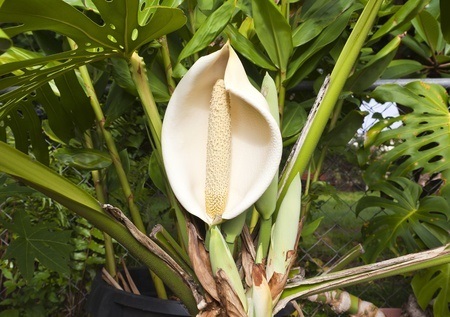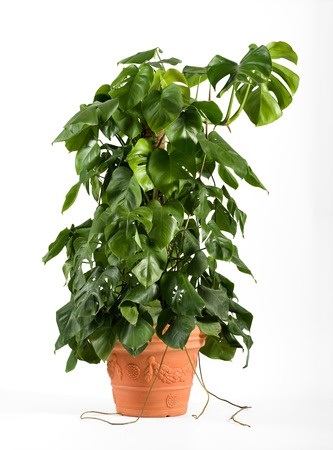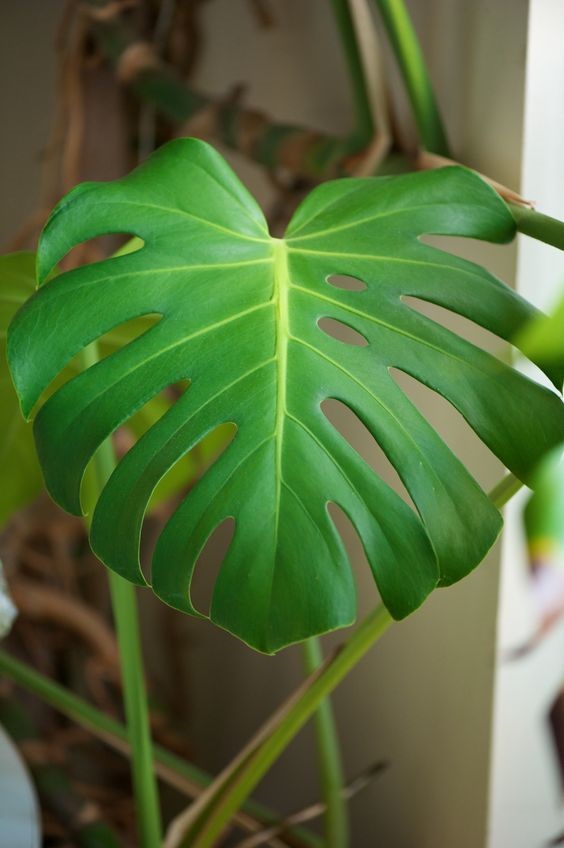





While this epiphyte plant - which is native to the rainforests in south America is a flowering plant, it's primarily grown indoors for its attractive foliage and the height it grows up to. It's a plant that becomes a focal point of a room once it matures.
The holes and cuts within the leaves are said to form so the plant survives well within it's natural rain forest habitat when strong winds and heavy downpours (I mean very heavy) appear. Leaves without these cuts and holes would get broken easily because of their size and the force of the weather conditions.
The Swiss cheese plant is fairly easy to care for and maintain, however, if the right conditions and care instructions are not followed the plant leaves can look very unattractive (see plant problems below).
Aerial roots: This species has aerial roots which are there to support the plant growing. These roots which hang from a stem have to be pushed into the compost and they can be placed on a moss stick (plastic tube with netting filled with peat), if you wish the plant to grow very tall.
How it looks: The monstera deliciosa is primarily grown indoors for the lush green and glossy leaves. Each heart shaped leaf that appears starts of as a full leaf and then begins to form it's slits. These leaves will grow whilst the plant is very young and only a matter of a few inches tall, although they do not produce the slits until it matures more. This species looks similar to a palm tree.
Flowering and fruit: The cheese plant does flower in it's natural habitat or somewhere that mimics it's natural habit very well. It's very rare to see them flower indoors. These flowers are a whitish colored spathe type with a spadix in the center.

The fruit which looks similar to a sweetcorn cone (in shape) are produced after the the flowers have fully bloomed. There is a specific way of knowing these are ready to be eaten, and if they're eaten before they become ripe enough it has been said they can cause mouth irritation. The name deliciosa comes from the fruit being known as tasting delicious.
Displaying and growing: These look fantastic in large rooms, hallways, within offices and anywhere else that can cater for their size and caring needs. To grow them tall they will have to be trained, which is fairly easy when using a moss stick. If you don’t have the time or materials to make a moss pole you can purchase them online or in garden stores which is probably a cheaper method. In the wild this plant grows by climbing (climbing shrub) trees (epiphyte) so it gains it's support and moisture from them - which a moss pole is used to imitate.


It's quite easy for a cheese plant to start looking very untidy once it matures in size and age. Here are some potential problems and their possible causes, so you can apply a solution to the problem.
Leaves yellowing: If your plant has quite a few leaves yellowing and they're wilting it's possible your over-watering it. If you know the plant has not been over-watered it could mean the plant soil needs fertilizer.
Leaf tips and edges turning brown: Low humidity and dry air is the most common fault here, although a pot bound plant can have the same affect on a plant.
Leaves not forming slits or holes: This is usually due to lack of something which will be light, not enough water or not enough fertilizer. If the plant is tall then you may want to check to see if the aerial roots are in compost and if they're not then place the roots in soil or on a moist moss pole.
Copyright © www.100flowers.win Botanic Garden All Rights Reserved